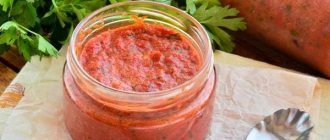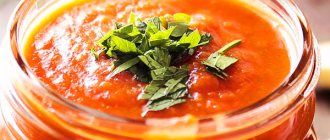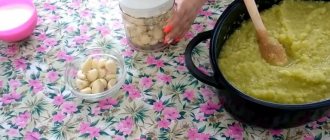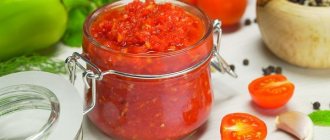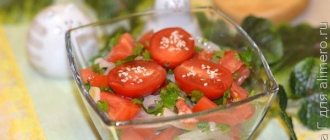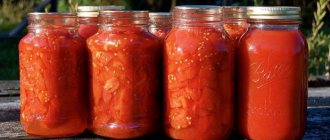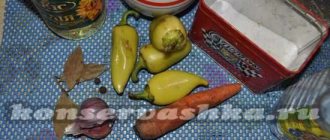Delicious homemade adjika for the winter is a popular vegetable preparation at home. Adjika recipes and cooking methods may vary. But it always turns out very tasty. Tomatoes make a fantastic snack. In just a few minutes, the spicy adjika will be ready. This treat is incredibly delicious. You can serve homemade tomato adjika with any side dish.
And also, amazing homemade adjika will fit perfectly into the menu of any festive table. As a snack for strong drinks, this yummy dish is undoubtedly suitable.
Any housewife can prepare perfect adjika from tomatoes at home; the recipe is simple and quick. This adjika can be stored in the refrigerator for quite a long time. Only, household members are unlikely to leave it untouched!
Adjika: myth and reality
Among homemade preparations for the winter, adjika is considered to be a very spicy sauce based on tomatoes, garlic and hot peppers, which is served with a wide variety of dishes, although it is more popular with meat or steamed vegetables. Modern lovers of spicy foods create more and more sophisticated recipes every year: with beets, pears or green tomatoes, without even realizing that in this way they are moving further and further from the essence, turning the spicy seasoning into an ordinary sauce, albeit a very tasty one.
In fact, adjika has nothing in common with tomatoes, nor with apples and carrots. The original version does not contain tomatoes and garlic, but only hot peppers, a special set of spices and walnuts. No heat treatment is used at the time of preparation. At the same time, adjika is prepared with rubber gloves - it has such a hot and pungent taste.
What national cuisine does this sauce belong to?
Adjika comes from Abkhazia, a mountainous country near the Black Sea, although Georgians constantly dispute this fact, claiming that the palm in creating this fiery seasoning belongs to them. The word “adjika” is a slightly modified “a-tsika”, which means “salt”. Yes, yes, ordinary salt, which is used for food in every home.
In ancient times, salt was a rather expensive product, and enterprising Abkhaz livestock breeders gave it to sheep to stimulate their appetite, which means more weight gain: meat and fat. At the same time, so that the poor mountain shepherds hired to look after the flock would not steal the expensive seasoning, salt was thickly mixed with pepper.
It is interesting that this fact did not bother the mountain Abkhazians at all; they additionally mixed bitter salt with various aromatic herbs and spices and sprinkled them on their food. This is how adjika arose - a spicy food seasoning that perfectly stimulates appetite and digestion.
Types of boiled adjika
Over time, the recipe for preparing this seasoning spread to other countries, but for the Slavs, who were not accustomed to such spicy food, it was too hot, so gradually adjika changed its composition almost beyond recognition, and the main distinguishing factor appeared: the presence of tomatoes and heat treatment. Nowadays there are a great variety of recipes for boiled adjika for the winter to suit a wide variety of tastes. This
- regular made from tomatoes and garlic;
- spicy from chili pepper;
- from tomatoes, bell peppers;
- with the addition of carrots, onions and various herbs;
- with sour apples;
- with the addition of plums and pears, boiled adjika becomes more like tkemali - another spicy sauce from mountainous countries;
- made from zucchini, carrots and hot peppers - in appearance, such adjika no longer resembles its ancestor, but rather resembles very spicy squash caviar.
A classic recipe with a modern twist
According to the most accessible recipe, boiled adjika for the winter is prepared from two kilograms of tomatoes, ground in a meat grinder with one and a half kilograms of sweet red pepper, chopped in the same way.
While the mixture of vegetables is boiling, prepare a spicy dressing: 2-4 cloves of garlic and half a pod of hot chili pepper are crushed, mixed with 5 tbsp. spoons of sugar and 4 tbsp. spoons of salt.
The resulting mass is added to the boiled adjika and boiled for about twenty minutes. At the end of cooking, pour in 100 grams of vinegar, let it boil and pour into jars.
Delicious adjika made from quince and plum
Ingredients:
- plums (ukorka) – 500 g;
- bell (sweet) pepper -1.5 kg;
- quince – 0.8-1 kg;
- garlic – 1 head;
- spices - to taste;
- salt/pepper - to taste;
- sugar – 1 tbsp. l.
A simple and tasty recipe for adjika from quince and plum for the winter:
First of all, let's prepare the products we need. To do this, first thoroughly wash the vegetables and fruits (plums, quinces, sweet peppers and peeled garlic). We sort and clean the quinces and plums from seeds and defective areas. We clean the sweet pepper from the core, membranes and seeds.
We install the smallest grate in the meat grinder (if it is impossible to use a meat grinder, use a regular blender) and pass all the prepared products through it: first plums and quinces, and then sweet peppers.
Please note: garlic is not added to adjika at this stage.
Place the resulting fruit and vegetable puree in a convenient saucepan (or cauldron) and put it on the fire. Mix everything and bring the contents of the pan to a boil.
As soon as adjika from quince and plum boils, add spices to it to taste (be sure to add salt and sugar). And if you wish, you can add ground black pepper and dried herbs. Once again, mix everything thoroughly and boil the homemade adjika for literally 3-4 minutes (so that the salt and sugar have time to completely dissolve).
Remove the pan from the heat, squeeze our already peeled garlic through a garlic press and mix everything very thoroughly again. Now cover the delicious homemade adjika with a lid and let it cool completely.
You can serve the unusual-tasting and delicious quince adjika immediately after preparing it. However, it’s best when it sits a little and gains flavor. To do this, you need to pour it into jars, seal it with lids and store it in a cold place.
Undoubtedly, such a tasty, aromatic and piquant dressing will decorate and complement any meat dish, serve as an excellent sauce for baked potatoes, or simply be a pleasant addition to a piece of fresh soft bread!
With apples and onions
Boiled adjika made from tomatoes and garlic is considered one of the most popular among the Russian-speaking population, and this version with apples is especially praised by connoisseurs of its refined taste, which gains strength thanks to the combination of sour fruit and bitter-spicy garlic. To prepare you will need:
- 500 grams of onions and carrots. Peel the onions and carrots. Pass the vegetables through a meat grinder or chop with a blender, place in separate bowls.
- 3 kg of meaty tomatoes.
- 600 grams each of sweet peppers and apples - remove the seeds and chop them too.
- 1/2 cup each of sunflower oil, sugar and vinegar 9%. In this case, it is recommended to use refined oil so that there is no foreign taste.
- 200 grams of peeled garlic.
- Salt is usually added to your taste: approximately one and a half to two tablespoons. l.
- 2 large pods of hot pepper. It is better to use red - it is more bitter and aromatic. Clean thoroughly and remove seeds.
- Dill and parsley, optional.
Tomatoes, chopped with a meat grinder and placed in a wide saucepan, put on fire. When they boil for ten minutes, add carrots to them, after another ten minutes - apples, sweet peppers and onions. Stir and cook for about an hour, stirring the mixture occasionally.
Grind hot pepper, garlic and fresh herbs in a meat grinder. Add sugar and salt to them, pour the resulting mass with garlic into the boiled adjika. Add vegetable oil and vinegar, boil for another thirty minutes, remembering to stir occasionally.
Turn off the stove and put the adjika boiled for the winter into sterilized jars, choosing ones that are not too large: half-liter and 250-gram jars are ideal. Roll up tightly with tin lids and place on the table bottom up, wrap with a warm blanket on top. When the sauce has completely cooled, you can put it away for winter storage.
Sweet and sour adjika with apples
Products:
- tomatoes – 5 kg;
- sweet pepper – 1 kg;
- apples – 1 kg;
- hot pepper – 4 pcs.;
- garlic, passed through a garlic press - 300 g;
- salt – 2 tbsp. l.;
- sugar – 1 tbsp;
- vinegar - 1 tbsp.
Step-by-step recipe for adjika with apples at home:
We rinse everything thoroughly with water, grind all the vegetables we have in a meat grinder, mix and cook for about 1 hour. Add pre-crushed garlic, salt, butter, sugar, table vinegar and cook for about an hour.
All is ready! All that remains is to put the sweet and sour adjika with tomatoes and apples into sterile jars and carefully roll up. Homemade adjika with tomatoes and apples is a delicious storehouse of vitamins for the whole winter. I recommend!
Adjika with basil and pears: a spicy taste for gourmets
Housewives note a sweet and sour taste, unusual for adjika, which develops into a scorching spiciness, seasoned with the spice of basil.
To prepare boiled adjika with basil you will need:
- Half a kilogram of onions and pears, the variety is not important, as long as the fruit is not spoiled, you don’t have to remove the peel - it adds tartness to the sauce.
- One and a half kilograms of ripe tomatoes. If the skin is hard, you can scald the fruit with boiling water and remove it.
- One kilogram of sweet bell pepper. Carefully remove the seeds.
- 130 - 150 grams of sugar.
- 100 grams of peeled garlic.
- 75 ml refined vegetable oil.
- 1 hot pepper; if you want a very spicy mass, take a larger size.
- 50 ml vinegar 9%.
- 1\2 tbsp. spoons of salt.
- A small bunch of basil (not suitable with purple leaves).
Grind the peeled vegetables in a blender into separate containers. Pour the mixture of tomatoes, sweet peppers, onions and pears into a large saucepan or cooking bowl, stir and put on fire. When the mixture boils for five to ten minutes, add oil and spices, cook for about forty minutes, stirring occasionally with a slotted spoon.
Grind the hot pepper and garlic in a blender, finely chop the basil with a knife and put the whole mass into adjika, let it simmer for another ten minutes. At the very end of the process, pour in vinegar, mix and you can put it in jars, which must be sterilized beforehand. Roll up with tin lids, turn upside down, wrap with something warm until completely cooled.
Adjika without tomatoes - 24 delicious homemade recipes
On 1000.menu, adjika recipes without tomatoes for the winter and beyond are presented in dozens of different items: with the addition of simple and more exotic ingredients, with and without heat treatment, with long-term storage or the “immediately on the table” option. The spiciness of the seasoning can be varied by adding hot pepper and garlic in different volumes.
In its classic form, adjika is always prepared without tomatoes - only red capsicum, garlic and many seasonings are added to it. But there are many variations of this aromatic paste - with the addition of not only tomatoes, but also bell peppers, zucchini, carrots, even apples. In principle, you can limit yourself to the classics - buy 1 kg of chili pepper (for example), a pair of thin rubber gloves (required) and start preparing.
Five of the fastest adjika recipes without tomatoes for the winter:
| Name of the dish | Cooking time | Calories kcal per 100g | User rating |
| Special hot adjika with Siberian bell pepper | 10 min | 106 | +14 |
| Adjika Georgian for the winter | 15 minutes | 260 | +191 |
| Dry adjika in Georgian style | 20 minutes | 111 | +46 |
| Adjika from green pepper in Abkhazian style for the winter | 20 minutes | 204 | +66 |
| Abkhazian adjika spicy classic | 20 minutes | 95 | +73 |
Here is an approximate recipe for adjika without tomatoes in its classic form:
- Wear rubber gloves. Remove all the seeds from the hot red pepper and grind it through a meat grinder twice or chop it in a blender until it becomes porridge.
- Crush the garlic in a mortar, mixing it with seasonings to taste: cilantro, utskho-suneli and salt.
- Grind the walnuts through a meat grinder.
- Mix both masses until smooth.
- Transfer to a suitable container (jar with a lid) and place in a cool place. As you can see, this version of adjika is not subjected to heat treatment. It is best to store it in the refrigerator. Due to the spiciness of pepper, it can be used in small quantities as an addition to a wide variety of dishes, including sugar-free cereals, casseroles, soups, meat, and so on. Adjika can be mixed with mayonnaise, preferably homemade, to get a tasty sauce. Rub it all over chicken and bake it in the oven to create a delicious crispy crust.
The five most commonly used products in adjika recipes:
| Product | Calories kcal per 100g | Proteins g per 100g | Fats g per 100g | Carbohydrates g per 100g |
| Hot pepper | 40 | 1.8 | 0.4 | 7.3 |
| Sugar | 398 | 0 | 0 | 99.7 |
| Tomato paste | 28 | 5.6 | 1.5 | 16.7 |
| bell pepper | 27 | 1.3 | 0 | 5.7 |
| Ground coriander | 25 | 1.5 | 5 | 0 |
Tips and tricks:
- if you lightly fry dry spices in a frying pan without oil, the smell of the finished adjika will be more aromatic
- if adjika is not intended for spreading on bread, but as a seasoning for other dishes, it is better to sprinkle more salt into it and then use it instead - in this form the sauce can be stored outside the refrigerator
- Another storage method is freezing: place adjika in ice trays, then sort the finished cubes into dry bags and keep in the freezer
Ukrainian spicy sauce
A simple recipe for boiled adjika from tomatoes for the winter can be prepared from simple ingredients:
- half a kilogram of carrots, sweet peppers (preferably red), very sour apples;
- two to three kilograms of maximally ripe, but not rotten tomatoes;
- one hundred grams of granulated sugar;
— 1 glass of sunflower oil, preferably refined;
- 1 tbsp. a spoonful of salt and red hot pepper, finely chopped with a knife.
Pour boiling water over the tomatoes for a few minutes and remove the skins from them, grind them with a blender or meat grinder along with all the vegetables. Mix in a wide saucepan with vegetable oil and cook, stirring occasionally, until desired consistency. Half an hour after boiling, add spices and pepper, which can be replaced with dry ground pepper if fresh is not available.
When the boiled adjika is brought to the required thickness, place it while still hot in sterilized jars and roll it up with a canning machine. Wrap it in a blanket folded in half for the night, and the next morning you can send it to the pantry or cellar. This recipe for boiled adjika from tomatoes is praised for the fact that it does not contain vinegar, which some people do not really like due to its specific smell and excessive acidity.
Adjika without garlic for the winter - general principles of preparation
Before starting the preparation processes, wash all products. The best option is to soak them in plenty of water. One or two hours of such a “bath” for vegetables will be quite enough.
The recipes offered below differ from each other not only in the preparation method, but also in the ingredients. Be sure to prepare everything according to the list, including the basics: tomatoes, peppers and spices.
Peppers should always be seeded and cored. This is done so that the bitter seeds do not clog the taste of adjika.
Tomatoes should be doused with boiling water. It's even better if they soak in hot water for at least 10 minutes. Then you can easily use a knife or fork to pry the tomato skin at the base and separate it from the vegetable.
And remember that the bright color of adjika is only given by the addition of hot, hot pepper; when you add it, taste it periodically, otherwise you may overdo it. Add pepper in small portions.
Secret from the masters
It is better to add salt during the cooking process before the bitter ingredients are added: garlic and pepper, otherwise the taste of the salt will be distorted by the spiciness and you can make a mistake, because the proportions of spices are always given “by eye”: some will find it too salty, but some, on the contrary, are tasteless.
Spices (coriander, suneli hops, black pepper) are usually not indicated in the recipe, because, again, everyone’s taste is different and so is their attitude towards herbs: some people like it, others don’t. Therefore, through trial and experimentation, over time, you will develop your own “basic” set of spices, which will be used in the preparation of boiled adjika.
